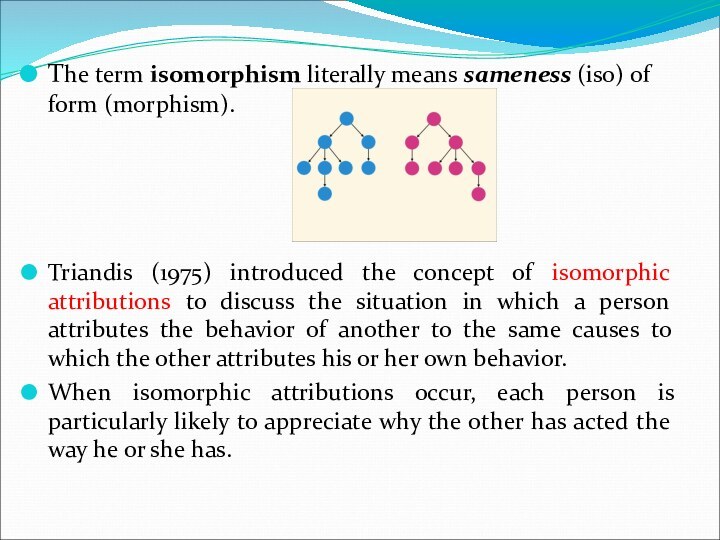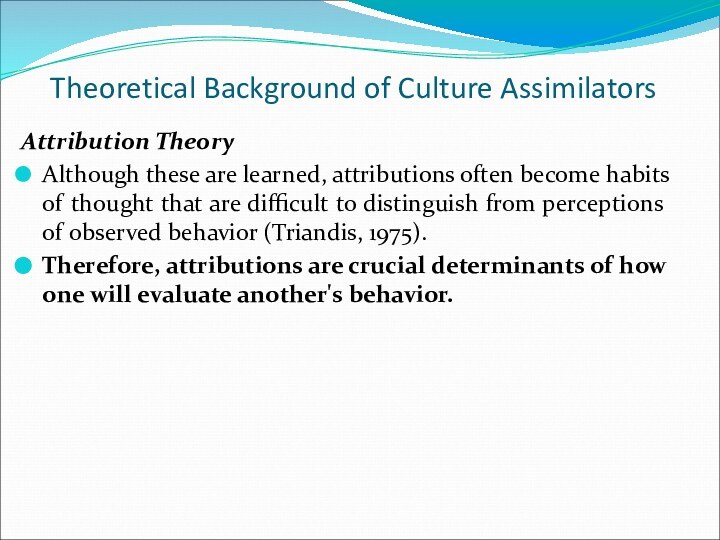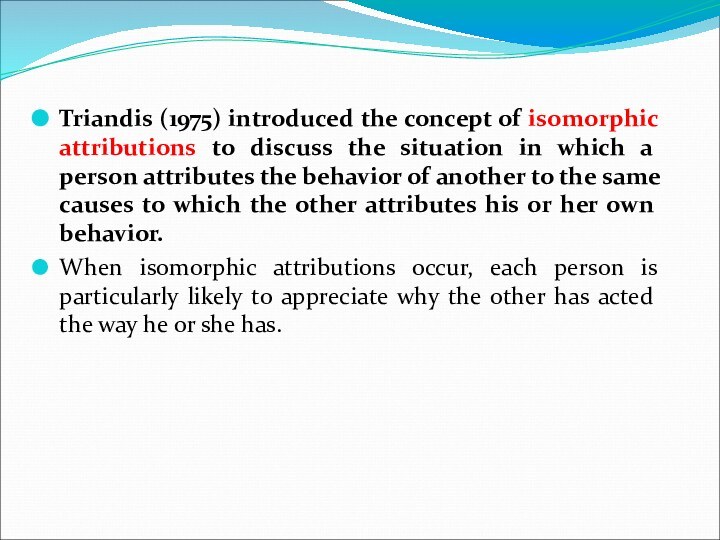- Главная
- Разное
- Бизнес и предпринимательство
- Образование
- Развлечения
- Государство
- Спорт
- Графика
- Культурология
- Еда и кулинария
- Лингвистика
- Религиоведение
- Черчение
- Физкультура
- ИЗО
- Психология
- Социология
- Английский язык
- Астрономия
- Алгебра
- Биология
- География
- Геометрия
- Детские презентации
- Информатика
- История
- Литература
- Маркетинг
- Математика
- Медицина
- Менеджмент
- Музыка
- МХК
- Немецкий язык
- ОБЖ
- Обществознание
- Окружающий мир
- Педагогика
- Русский язык
- Технология
- Физика
- Философия
- Химия
- Шаблоны, картинки для презентаций
- Экология
- Экономика
- Юриспруденция
Что такое findslide.org?
FindSlide.org - это сайт презентаций, докладов, шаблонов в формате PowerPoint.
Обратная связь
Email: Нажмите что бы посмотреть
Презентация на тему The Culture Assimilators (The Intercultural sensitizer)
Содержание
- 2. The culture assimilator is a programmed learning
- 3. The term isomorphism literally means sameness (iso)
- 4. Sample Assimilator Item (Tolbert & McLean, 1995)
- 5. Why did the negotiations between Paul and the Venezuelan firm not produce the results he expected?
- 6. a. Paul should not have taken the
- 7. You answered:a. Paul should not have taken
- 8. You answered:b. Paul’s company made the unfortunate
- 9. You answered:c. By dropping to an informal
- 10. You answered:d. The company was not ready
- 11. The culture assimilator is a cross-cultural training
- 12. Culture assimilators can be designed to provide
- 13. These scenarios or vignettes are called critical
- 14. The basic premise of the critical incident
- 15. At the end of the critical incident
- 16. In effect, the reader is asked to
- 17. For each of the alternatives, an explanation
- 18. Hence, the culture assimilator consists of a
- 19. EnglandSarah Smiths is an American young woman
- 20. What was the problem at the office?
- 21. 1. To flirt at a work place
- 22. England case 25 response 1 You answered:To
- 23. England case 25 response 2 You answered:Sarah
- 24. England case 25 response 3You answered:Sarah’s colleagues
- 25. England case 25 response 4 You answered:Sarah’s
- 26. Theoretical Background of Culture AssimilatorsAttribution TheoryAttributions
- 27. Theoretical Background of Culture AssimilatorsAttribution TheoryAlthough
- 28. Triandis (1975) introduced the concept of isomorphic
- 29. When trainees use an assimilator, they learn
- 30. Cultural assimilators:Culture-specific assimilatorsCulture general assimilator
- 31. Culture-specific assimilatorsThe early culture assimilators were developed
- 32. Culture general assimilatorBrislin et al. (1986) developed
- 33. Culture general assimilatorThis assimilator consists of 100
- 34. ChinaMr. Brown, a representative of a large
- 35. What was the reason for the unwillingness of Chinese managers to take the position?
- 36. A. The Chinese are proud of their
- 37. China case 6 Response AYou answered:The Chinese
- 38. China case 6 Response BYou answered:The Chinese
- 39. China case 6 Response CYou answered:The Chinese
- 40. China case 6 Response DYou answered:The core
- 42. Example: THE DEVELOPMENT OF THE VENEZUELAN CULTURE
- 43. Phase 2: Critical Incident/Episode Construction. From the
- 44. Phase 3: Elicitation of Attributions. This phase
- 45. Phase 4: Attribution Construction. The attributions received
- 46. Phase 5: Final Incident/Validation. The completed 41
- 47. Brislin, Landis, and Brandt (1983) identify the
- 48. Brislin, Landis, and Brandt (1983) identify the
- 49. Overall, the research indicates that the culture
- 50. ChinaPeter, the businessman from Toronto has come
- 51. A. They didn’t want to work with
- 52. China case 15 Response AYou answered:They didn’t
- 53. China case 15 Response BYou answered:It was
- 54. China case 15 Response CYou answered:Food was
- 55. China case 15 Response DYou answered:They did
- 56. The culture assimilator has many advantages (Albert,
- 57. There are limitations to this training technique
- 58. There are limitations to this training technique
- 59. Скачать презентацию
- 60. Похожие презентации



























































Слайд 3 The term isomorphism literally means sameness (iso) of
form (morphism).
Triandis (1975) introduced the concept of isomorphic
attributions to discuss the situation in which a person attributes the behavior of another to the same causes to which the other attributes his or her own behavior. When isomorphic attributions occur, each person is particularly likely to appreciate why the other has acted the way he or she has.
Слайд 4
Sample Assimilator Item (Tolbert & McLean, 1995)
A U.S.
negotiation firm assigned Paul, a top negotiator, to buy
raw materials from Venezuela. Paul had been abroad for several years in other Latin American countries, so he knew both formal and street Spanish. During some of the negotiations with the Venezuelan firm, Paul brought the presentation down to an informal level of speech. He noticed that the Venezuelans were listening attentively and seemed to follow the ideas and business plan he presented. He was joking around and talking like "one of the boys" since he was confident about the Latin business atmosphere. The Venezuelans listened politely until the end of the presentation. When Paul was finished, they thanked him and he left.A week later Paul's manager called him into his office. Paul told him how wonderful the trip to Venezuela was and that he was anxious to hear what had happened. The manager then told Paul that he was about to ask him the same thing - what had happened? The Venezuelan firm called his company and refused to do business with them in the future. Paul was very upset and had no idea what had happened.
Tolbert, A. S., & McLean, G. N. (1996). Venezuelan culture assimilator for training United States professionals conducting business in Venezuela. International Journal of Intercultural Relations, 19(1), 111-125.
Слайд 5 Why did the negotiations between Paul and the
Venezuelan firm not produce the results he expected?
Слайд 6 a. Paul should not have taken the initiative
in changing the atmosphere and the relationship with the
Venezuelans to an informal level. He should have respected the tone set by the Venezuelans. Because of his actions, he was perceived as condescending.b. Paul’s company made the unfortunate assumption that Paul was qualified to enter the Venezuelan culture successfully because of his prior experience in Latin America. Paul relied too heavily on his presumed understanding of the culture. He assumed that all Latin American countries were the same, and he was too informal for the Venezuelan culture.
c. By dropping to an informal level so quickly, Paul created doubt in the minds of the Venezuelans as to the seriousness of the proposal and his company. In Venezuela, a company's approach is a very important part of maintaining its reputation
d. The company was not ready to make a decision yet. The Venezuelans needed to call more meetings with Paul and get to know him, perhaps over lunches or dinners. The deal needed to be discussed more.
Слайд 7
You answered:
a. Paul should not have taken the
initiative in changing the atmosphere and the relationship with
the Venezuelans to an informal level. He should have respected the tone set by the Venezuelans. Because of his actions, he was perceived as condescending.You selected a. When looking at this situation from a U.S. perspective, it is a reasonable response. However, being informal is not necessarily the same as being condescending. While Paul should have respected the tone set by the Venezuelans, there is a more plausible response to this scenario.
Please choose again.
Слайд 8
You answered:
b. Paul’s company made the unfortunate assumption
that Paul was qualified to enter the Venezuelan culture
successfully because of his prior experience in Latin America. Paul relied too heavily on his presumed understanding of the culture. He assumed that all Latin American countries were the same, and he was too informal for the Venezuelan culture.You selected b. This is a good choice. Some Latin American countries do encourage informal business relationships, but that is not the case in Venezuela. Paul should have explored the Venezuelan norms of business relationships before acting in a more informal manner. It is dangerous to assume commonalities in values, beliefs, and practices within countries that merely share a common language. There is another choice, however, that was preferred by Venezuelans.
Please choose again
Слайд 9
You answered:
c. By dropping to an informal level
so quickly, Paul created doubt in the minds of
the Venezuelans as to the seriousness of the proposal and his company. In Venezuela, a company's approach is a very important part of maintaining its reputationYou selected c. This is the choice chosen most often by Venezuelans. Venezuelans prefer a formal to semiformal work environment and mode of communication. Breaking that norm created doubt in the Venezuelans' minds as to how professional and credible Paul and his company were, in Venezuela, a company's credibility is often determined by its approach to business. The business approach is a very important part of establishing and maintaining one's reputation.
Слайд 10
You answered:
d. The company was not ready to
make a decision yet. The Venezuelans needed to call
more meetings with Paul and get to know him, perhaps over lunches or dinners. The deal needed to be discussed more.You selected d. Perhaps the company may not have been ready to make a decision yet. However, the actual response of the Venezuelans was to threaten not to do business in the future with the company, which is a stronger message than simply saying that they are not ready to make a decision. Such a dramatic response is more indicative of an error of something that he did rather than something that he failed to do.
Please choose again.
Слайд 11 The culture assimilator is a cross-cultural training tool
that consists of a number of real-life scenarios describing
puzzling cross-cultural interactions and explanation for avoiding the emerging misunderstandings.…….and in a number of studies the effectiveness of this method has been established (Bhawuk, 1998;).
Слайд 12 Culture assimilators can be designed to provide various
emphases (Fiedler et al., 1971):
(a) interpersonal attitudes that
address a contrast between the home culture and the target culture,(b) the customs of the other culture,
(c) the contrasting values of the two cultures,
(d) the various social situations that may be encountered at work, home life, etc.
Слайд 13 These scenarios or vignettes are called critical incidents
(Flanagan, 1954).
These critical incidents describe intercultural interactions between
a sojourner and a host country national that depict a misunderstanding because of cultural differences between the two people.
Слайд 14
The basic premise of the critical incident is
identified as follows:
(a) a
situation in which two persons from different cultures interact; (b) a situation in which a person from one culture finds himself or herself in conflict, in the midst of a misunderstanding, or simply puzzlement;
(c) a situation which can be interpreted in a fairly unequivocal manner, given sufficient knowledge about the culture (Fiedler et aI., 1971, p. 97).
Слайд 15 At the end of the critical incident a
question is posed that asks the reader to reflect
on the scenario and think about the source of misunderstanding.The question is followed by four or five alternatives that are plausible behavioral choices for a person facing such a social situation.
Слайд 16
In effect, the reader is asked to make
attributions and then to compare his or her attributions
with the ones provided at the end of the incident.One of these alternatives represents a view from one of the two cultures involved in the situation and a second one captures the views of the second culture.
The rest of the alternatives try to capture a range of individual differences present in either of the cultures, but are usually less appropriate or desirable.
Слайд 17
For each of the alternatives, an explanation is
offered, usually on a separate page.
The explanation gives
the rationale why a particular behavior (alternative) is not appropriate in the given situation.
Слайд 18
Hence, the culture assimilator consists of a number
of critical incidents that have three parts:
an incident or
a short story;four or five alternative behavioral choices or attributions;
explanations or feedback about why an alternative is to be preferred or not.
Слайд 19
England
Sarah Smiths is an American young woman who
after graduation from Californian University, Los Angeles, decided to
fulfill her dream and to live in London. After a couple of weeks in England she found an office job. All her colleagues seemed to be very nice to her, however from the first day at work the woman noticed that some of her male colleagues were openly flirting with her. Wherever she went to: copying room, cafeteria or to smoke on a balcony – her colleagues were flirting with her and embarrassing her. Sarah have already had some work experience in the U.S.A and she knew the unbreakable rule: "no romance in the office” (otherwise it can be interpreted as "sexual harassment“). Now she was trying to dress even more modestly and started to avoid eye-contact with her colleagues, as well as drinking coffee and going out to smoke. After a week at work Sarah became very nervous about the situation and still could not understand why people were flirting with her, though she never responded.Слайд 21 1. To flirt at a work place is
common in England.
2. Sarah is a young and
attractive girl from California, Los Angeles. According to English stereotype very open and somewhat frivolous people are coming from there. Understanding this fact, people in the office were just trying to be friendly with the woman and make her feel "at home".3. Sarah's colleagues were simply making fun of the "new-comer"; they were especially motivated when they saw the woman's embarrassment and eye contact avoidance.
4. Sarah's mistake was her misinterpretation of the dress code. Her clothes were very open according to the English unwritten rules.
Слайд 22
England case 25 response 1
You answered:
To flirt at
a work place is common in England.
This is the
correct answer!Both ‘romantic flirting’ and ‘flirting without any reason’ are ordinary in English offices and different workplaces. Flirting is considered to be good for relaxation and decreasing of stress according to the English people, as far as the atmosphere becomes less tense as well as compliments help people to cooperate more. However in America flirting in the office is banned, that’s why Sarah felt so embarrassed.
Слайд 23
England case 25 response 2
You answered:
Sarah is a
young and attractive girl from California, Los Angeles. According
to English stereotype very open and somewhat frivolous people are coming from there. Understanding that people in the office were just trying to be friendly with the woman and make her feel “at home”.Incorrect.
Usually English people will not be flexible to adapt to someone’s culture, especially if only one foreigner is involved. There is no evidence of such a stereotype in England as to believe that people from California are frivolous and open.
Please choose again
Слайд 24
England case 25 response 3
You answered:
Sarah’s colleagues were
simply making fun of the “new-comer”; they were especially
motivated when they saw the woman’s embarrassment and eye contact avoidance.Incorrect.
English people are usually nice and friendly to new-comers at work and there is no unwritten rule to make fun of a new person.
Please choose again.
Слайд 25
England case 25 response 4
You answered:
Sarah’s mistake was
her misinterpretation of the dress code. Her clothes were
very open according to the English unwritten rules.Incorrect.
Dress code is a very important issue in English culture. A person must know what, where and how to wear and one must remember that the English people do not like to show off with very expensive clothes, however this information is not relevant for the case.
Please choose again.
Слайд 26
Theoretical Background of Culture Assimilators
Attribution Theory
Attributions are
inferences about the cause of an event or a
person's motives.Attribution theory began with Heider's (1944, 1958) seminal analyses of how people perceive and explain the actions of others.
According to Heider (1958), people operate very much like quasi-scientists in their attributional activities. They observe an event, and then often in a logical, analytical way, attempt to connect it to possible causes and various effects.
In general, attributions are considered to be dependent on the norms, affect, roles, and the consequences of actions seen as operating in a social situation (Triandis, 1975).
Слайд 27
Theoretical Background of Culture Assimilators
Attribution Theory
Although these
are learned, attributions often become habits of thought that
are difficult to distinguish from perceptions of observed behavior (Triandis, 1975).Therefore, attributions are crucial determinants of how one will evaluate another's behavior.
Слайд 28 Triandis (1975) introduced the concept of isomorphic attributions
to discuss the situation in which a person attributes
the behavior of another to the same causes to which the other attributes his or her own behavior.When isomorphic attributions occur, each person is particularly likely to appreciate why the other has acted the way he or she has.
Слайд 29 When trainees use an assimilator, they learn to
identify behaviors that are appropriate in their own culture
but not appropriate in another culture, and learn to make attributions that are similar to those made by people in the host culture.In other words, they learn to make isomorphic attributions (Triandis, 1975).
Слайд 31
Culture-specific assimilators
The early culture assimilators were developed with
a pair of cultures in mind, usually to prepare
Americans to live in another culture, e.g., Thailand, Iran etc.They helped the trainees learn inductively to avoid certain behaviors that are not acceptable in the host culture (Triandis, 1994, p. 26).
Слайд 32
Culture general assimilator
Brislin et al. (1986) developed a
culture general assimilator. The culture general assimilator uses the
same format as the culture-specific assimilators, i.e., critical incidents, alternatives, and explanations for the alternatives.
Слайд 33
Culture general assimilator
This assimilator consists of 100 critical
incidents that cover 18 themes or categories like
Work,
Time and Space,
Prejudice and Ethnocentrism,
Roles,
Importance of the group and the importance of the individual,
Rituals and superstitions,
Hierarchies: class and status,
Values, and so forth, that have been identified in the literature as important for the sojourners to be sensitive to.
Слайд 34
China
Mr. Brown, a representative of a large American
corporation, was looking for an experienced employee to occupy
the position of Chief Financial Officer of a subsidiary in Beijing. Although the corporation had been experiencing hard times due to a recession, it was well-known in business circles. After several unsuccessful attempts, Mr. Brown found a person who would perfectly suit the position and invited him for an interview. Mr. Chi worked for a Chinese corporation, where he was underpaid. Although Mr. Brown offered him a high salary and mentioned additional benefits, Mr. Chi did not seem enthusiastic about the offer. In his own research about the American corporation, he had found out that the corporation’s bottom line was very low during the last three years and the stock market price had dropped. Mr. Chi decided not to take the position. So did other Chinese managers who were offered the job.Слайд 36 A. The Chinese are proud of their country
and prefer working for Chinese corporations only.
B. The Chinese
prefer secure jobs to highly paid jobs.C. The Chinese are very responsible people. Mr. Chi was afraid that he would not be able to solve the company’s challenges.
D. The core of the Chinese culture is social equality. Mr. Brown should have found something else to attract potential employees.
Слайд 37
China case 6 Response A
You answered:
The Chinese are
proud of their country and prefer working for Chinese
corporations only.Incorrect.
Although pride in their country is an inalienable part of Chinese culture, many Chinese people work for international corporations and joint ventures.
Please try again
Слайд 38
China case 6 Response B
You answered:
The Chinese prefer
secure jobs to highly paid jobs.
This is the correct
answer!Life stability is important for the Chinese. They are afraid of any uncertainty related to their job.
Слайд 39
China case 6 Response C
You answered:
The Chinese are
very responsible people. Mr. Chi was afraid that he
would not be able to solve the company’s challenges.Incorrect.
Although the Chinese are responsible people, to take or reject the position is a personal decision.
Please try again
Слайд 40
China case 6 Response D
You answered:
The core of
the Chinese culture is social equality. Mr. Brown should
have found something else to attract potential employeeIncorrect.
Although China is a socialist country, money is of the same importance in China as in democratic countries. This cannot be the reason for rejecting the position.
Please try again
Слайд 42 Example: THE DEVELOPMENT OF THE VENEZUELAN CULTURE ASSIMILATOR (Tolbert,
A. S., & McLean, G. N. (1996). Venezuelan culture
assimilator for training United States professionals conducting business in Venezuela. International Journal of Intercultural Relations, 19(1), 111-125.)Phase I: Interviews.
The first phase involved interviewing 16 Venezuelan business professionals who had conducted business with individuals from the United States and 12 business professionals from the United States in Venezuela on business.
The interviews provided actual incidents of cultural misunderstandings. These incidents served as the basis of the episodes for the assimilator.
Слайд 43
Phase 2: Critical Incident/Episode Construction.
From the 28
interviews conducted, 63 episodes were written around the cultural
misunderstandings; a question was posed at the end of each incident.Episodes that were redundant or unclear or that represented differences other than cultural differences were eliminated.
The result was 58 short stories or episodes.
Слайд 44
Phase 3: Elicitation of Attributions.
This phase obtained
the various responses that represented the way that the
two cultural groups perceived the same situation.Packets of 10 episodes were given to each participant: 25 Venezuelans and 25 individuals from the United States in Venezuela. The participants were asked to answer the question posed at the end of each episode.
The questions addressed the reason that the person from culture A responded that particular way to the person from culture B.
Differences and similarities in the way the two groups responded were found.
Слайд 45
Phase 4: Attribution Construction.
The attributions received from
the participants were reviewed; at least eight responses were
received for each episode. Each response was categorized as Venezuelan or United States, depending on the culture of the people giving the response.At this point, the cultural experts were again contacted; they reviewed the episodes and the attributions. The incidents were reduced from 58 to 41 when the experts agreed that some episodes did not seem clear in content, did not represent cultural differences, or did not receive a sufficient number of feasible attributions.
The experts also selected the most appropriate attributions.
Слайд 46
Phase 5: Final Incident/Validation.
The completed 41 critical
incidents, with a question posed at the end, with
4-5 attributions each following, were distributed to a new sample of Venezuelans in Venezuela and individuals from the United States in the United States.Слайд 47 Brislin, Landis, and Brandt (1983) identify the following
benefits from the use of a culture-specific assimilator:
1. Greater
understanding of hosts, as judged by the hosts themselves;
2. A decrease in the use of negative stereotypes on the part of trainees;
3. The development of complex thinking about the target culture, which replaces the oversimplified, facile thinking to which hosts react negatively;
Слайд 48 Brislin, Landis, and Brandt (1983) identify the following
benefits from the use of a culture-specific assimilator: 4. Greater
enjoyment among trainees who interact with members of the target culture, a feeling reciprocated by hosts; 5. Better adjustment to the everyday stresses of life in other cultures; 6. Better job performance in cases in which performance is influenced by specific cultural practices that can be covered in the training materials.Слайд 49 Overall, the research indicates that the culture assimilator
is an effective culture training tool. Albert (1983) states
that there are research findings that demonstrate the positive impact on the cognitive, behavioral, and affective domains of trainees.
Слайд 50
China
Peter, the businessman from Toronto has come for
a meeting with Chinese colleagues. Due to their long
term business relationship, he has been invited by the Chinese company to discuss the new contract. The hosting company has invited Peter at the first day of his arrival. As soon as they started eating, Peter began to talk about the advantages of their common work, his expectancies of the Chinese colleagues in the future and how they can benefit from his enterprise. However, the Chinese colleagues have not shown great interest. They were rather trying to talk about family members and not about holiday. Eventually they started to talk about food.Why weren’t they interested in the discussion?
Слайд 51 A. They didn’t want to work with Peter’s
company anymore and just did not know how to
tell him that.B. It was the 4th of May, hence simply not the right day to discuss this matter.
C. Food was too good; they could not focus on something else.
D. They did not want to discuss business whilst having dinner.
Слайд 52
China case 15 Response A
You answered:
They didn’t want
to work with Peter’s company anymore and just did
not know how to tell him that.Incorrect.
They invited him to discuss a new contract, which might mean that they still wanted to work with his firm.
Please try again
Слайд 53
China case 15 Response B
You answered:
It was the
4th of May, hence simply not the right day to
discuss this matterIncorrect.
It might be a reason as well, but we have a lack of information.
Please try again
Слайд 54
China case 15 Response C
You answered:
Food was too
good; they could not focus on anything else
Incorrect.
Food was
just one of the themes.Please try again
Слайд 55
China case 15 Response D
You answered:
They did not
want to discuss business whilst having dinner
This is the
correct answer!Chinese people generally do not discuss business while having their meal. Culturally, their conversation while having a meal focuses on the meal itself or different other topics such as art, sights, family, etc.
Слайд 56
The culture assimilator has many advantages (Albert, 1986):
(a)
trainees are active participants,
(b) the programmed learning format that
it uses gives the trainees immediate feedback on the choices they have made, (c) it can be used individually or in groups,
(d) it can be used alone or with a facilitator,
(e) other training approaches and techniques may be used with the culture assimilator.
Слайд 57 There are limitations to this training technique as
well. Albert (1983)warns against the following:
(a) some of the
more complex interactions will be difficult to convey through simple episodes, (b) the format of the culture assimilators may cause trainees to focus their attention on the more obvious aspects of the individual situations and not on the underlying themes or motives,
Слайд 58 There are limitations to this training technique as
well. Albert (1983)warns against the following:
(c) not all sources
of misunderstanding can be covered in a culture assimilator,(d) the culture assimilator is limited to teaching only those concepts and principles that can be conveyed verbally,
(e) culture is ever changing, so culture-specific assimilators may need frequent updating.





























